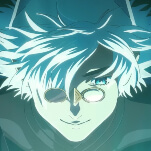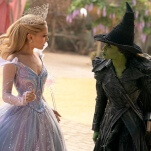The dreamy Black Cloud reads like a love child of Labyrinth and Inception
The flexibility to form and reform comics creative teams is both one of the genre’s biggest strengths and longest-running frustrations. A shift in writer or artist can change the tone and direction of a book enough to make inconsistency a problem, but different combinations of new team members can also lead to interesting, innovative books that could only exist with that particular group.
With Black Cloud #1 (Image), a team like that has assembled. Written by Jason Latour and Ivan Brandon, with art by Greg Hinkle and colors from Matt Wilson, Black Cloud tackles a story of dreams, history, and family, all centered around a young woman very far from her home. Latour’s reputation these days is centered around his work on Spider-Gwen and with Jason Aaron on Southern Bastards. Brandon’s writing for Drifter has bolstered his own name recognition, and it’s interesting to see the two of them working together. Latour is at his best when he has a close collaborator and a big sandbox to play in; his talent feels constrained when working with someone else’s intellectual property and both he and Brandon excel when they’re allowed to stretch their creative legs. Black Cloud is no exception. The book’s protagonist, Zelda, comes from a world where dreams are very real and literal things, a world where people with the right kind of skill can manipulate and manage and navigate those dreams in ways that most can’t. Unfortunately, Zelda is caught in our world, bound by the reality of money and the lack thereof.
Greg Hinkle doesn’t have the same length of bibliography as the writing team, but some readers may recognize his name from 2015’s Airboy, a four-issue run perhaps best known for transphobic content instead of the actual story. Hinkle’s style is detailed without being unduly cluttered, and he has particular skill with motion. Zelda gets into a couple of scuffles in this 30-page first issue, and while she manages to keep her cool most of the time, the characters around her are thrown into visually appropriate chaos. There are a couple of neat panels that would make great shots in a movie, stacked nicely with interesting perspectives.
Sticking to truly fictional characters instead of fictionalized versions of himself is safer territory for Hinkle right now, and he does well with Black Cloud.
But what shines in this issue is Matt Wilson’s work. The dreamscape is demonstrated through color and texture, going from grayscale to Technicolor-esque and back again. Zelda’s forays into our reality are in turns muted and neon, and without Wilson’s skill it would be hard to tell where she finds herself on any given page. The story is interesting, the love child of Labyrinth and Inception with even more morally ambiguous decisions. But without Wilson’s colors, this book could feel too familiar, too close to things readers have already seen before. It’s the perfect demonstration of the many things it takes to make a successful comic, and the importance of picking the right team.
[Caitlin Rosberg]
Spider-Man is a stranger in his own story in Amazing Spider-Man
Dan Slott has been writing Spider-Man for almost 10 years. He was made sole writer of the title in 2010, and since then the book has never been far from Marvel’s best-selling title. Amazing Spider-Man is one of the most coveted jobs in the industry, and Slott’s longevity on the title is a testament to the fact that not only does he understand Spider-Man, but also understands what fans want to see in a Spider-Man story—not the same thing at all.
All good things must come to an end, and it would seem as if Slott’s blockbuster run may be drawing to a close. Last month wrapped The Clone Conspiracy, a crossover built around revisiting the mid-’90s “Clone Saga.” However, where Spider-Verse and Superior Spider-Man both sold quite well, The Clone Conspiracy does not seem to have landed quite so firmly. Part of the problem may be the storyline’s dependence on the current plot in Amazing, with Peter Parker a multi-billionaire. Spider-Man still sells well, but fan response to a filthy-rich Peter Parker has been muted. To be fair, this was clearly never intended to be a permanent status quo, and certainly the promise of seeing Peter screw it all up and be sent back to square one is the major source of dramatic tension. With Amazing Spider-Man #26 (Marvel) the story enters its home stretch, and not a moment too soon: Seeing Spider-Man jetting around the globe may have been a novelty once, but it bends the series’ core themes too much to ever see Peter succeed at one thing for too long.
With clones in the rearview mirror, Slott is free to take the current storyline to its inevitable conclusion. A few dangling plot threads have been assembled—Silver Sable is back (believed dead since Ends Of The Earth), and she’s trying to kill Norman Osborn, now an international arms dealer who has seized control of Sable’s home country of Symkaria. If this doesn’t sound like a Spider-Man story, it’s because it’s not. It’s a story that has Spider-Man in it, but he’s doing things like using his multi-billion-dollar corporation to launch an attack on a sovereign nation in the hopes of helping Sable oust Osborn. Rich Spider-Man is just as short-sighted as broke Spider-Man, because invading a sovereign nation in the Marvel Universe is a great way to become a target of S.H.I.E.L.D. It certainly looks fantastic because Stuart Immonen is on board, inked by Wade Von Grawbadger. It’s not their fault the storyline is so odd.
Superior Spider-Man ended with Norman Osborn, too. Osborn, you may recall, was dead for 25 years before being resurrected to serve as deus ex machina to wrap up the original Clone Saga. Osborn has now been back 21 years, and in that time the character has morphed into something completely unrecognizable, more akin to Lex Luthor or Maxwell Lord than the Green Goblin of yore. So rich Spider-Man and evil dictator Green Goblin get to face off in a massive international invasion—two characters acting very much unlike themselves, doing things that bear only passing resemblance to anything they’ve ever done in the past. At least if Peter fails at being a billionaire he can take solace in the fact that there is still one good career path open for disgraced tycoons: the presidency.
[Tegan O'Neil]
From two extremely active imaginations comes Eleanor & The Egret, a strange new crime story
John Layman and Sam Kieth are two comic-book creators known for compelling high concepts: Layman is the writer behind Chew, starring a cibopathic detective who psychically learns the history of whatever he eats, and Kieth is the creator of The Maxx, one of the strangest superheroes ever brought to the page. They’ve combined their extremely active imaginations for a new ongoing series, Eleanor & The Egret (AfterShock), and the results are as beautiful as they are strange and surprising. Set in an alternate-universe Paris that never grew out of the art-nouveau aesthetic, the story follows an art thief and her magical egret as they steal an abstract masterpiece and quickly end up in the path of the detective investigating the robbery.
The first thing that came to mind after reading Eleanor & The Egret #1 was Brandon Graham’s King City, which also features a pet with extraordinary abilities used for crime. The two books have very different styles and structures, but they both share a strong sense of humor and an eagerness to invigorate a crime story with more fantastic genre elements. The setting immediately gives Eleanor & The Egret series a distinct look, and Kieth does spectacular work evoking turn-of-the-century France in the costumes and architecture. The time period is ambiguous—the museum’s security system features anachronistic technology and Eleanor’s fashion veers toward a modern sporty look in the back half—but rooting the designs and layouts in art nouveau makes the book stand out in AfterShock’s lineup and the larger comics industry.
From the very start, it’s clear that this series is going to be driven by Kieth’s artwork with colorist Ronda Pattison. That’s not a slight on Layman’s story, which moves at a brisk pace and introduces an engaging cast of characters (human and animal), but it’s hard to imagine it having the same impact without Kieth and Pattison’s visuals. The first page is a gorgeous sequence with meticulous art-nouveau borders that swirl and hook around the panels, a delicate flourish that contrasts with the bleak, dark swamp Eleanor runs through. The framing of the last panel on that page is an especially strong blend of art-nouveau composition and horror comic imagery, and much of the fun of reading this first issue is seeing how Kieth energizes the visuals by incorporating art-nouveau elements in the designs, panel shapes, and gutters.
As the colorist of IDW’s remastered versions of The Maxx, Pattison has developed a very strong understanding of what works best for Kieth’s artwork. Her palettes reinforce the atmosphere of each scene; the murky blues and greens of the swamp prologue emphasize the nastiness of that environment and set it apart from the pristine, cream-colored interior of the art museum. Eleanor’s skin blends into those walls, visually indicating her comfort in this place and her ability to slip into the background unnoticed. The purple and pinks of the panels showing Eleanor and her egret in action heighten the fantasy of the caper, and Pattison does remarkable work matching the shifting qualities of Kieth’s linework in her rendering. Eleanor & The Egret is worth the cover price for the artwork alone, but there’s also plenty to enjoy in the story, particularly the cliffhanger that makes it very hard to resist buying the next issue. [Oliver Sava]
[Oliver Sava]
Simply Samuel’s irresistible momentum builds to a slyly explosive conclusion
Tommi Musturi’s comics are deceptively simple. His latest, Simply Samuel (Fantagraphics Books), follows nameless cyclopean figures on a dizzying number of picaresque adventures, but these seemingly anodyne adventures build into something dizzyingly complex. The book opens with a slow sequence of a tear forming in a woman’s eye; it rolls slowly down her chin, falls through the air, and forms the gray-white humanoid that we follow through the book. The press for the book identifies this figure as the titular Samuel, but Musturi seems to omit or obscure that information in the text itself. As the book continues, Musturi introduces other characters who resemble Samuel, and the combined absence of words and lack of differentiating characteristics makes it difficult to pick Samuel out in a scene.
Therein lies the play of Musturi’s work—a game between the simple and the complicated. This confusion of characters gives the sense that each of Samuel’s adventures are discrete modules, as they appear to not follow a single character. Rather than narrative, they appear to be abstract, poetic, not to be understood in conventional terms of story, plot, and character. It is only after careful reading that a protagonist can be discerned. In much the same way, Musturi’s aesthetic is deceptively simple; at first glance it appears to be one thing, but as the reader spends more time reading, that first impression withers away. His lines are clean and his images stripped of unnecessary detail. Likewise, he prefers geometric shapes and flat colors. Everything is delicately composed—even the pages are organized on a strict four-panel grid—and it appears flat and almost boring. But these built-up expectations and rhythms become bombs, both of which Musturi detonates by book’s end.
This explosion near book’s end comes in a series of frenetic and cacophonous pages that appear completely divorced from the others in the book. A far cry from the previous ultra-lean compositions, these feature hyper-dense scenes of chaos and anarchy. Rather than colored in the now-familiar flat hues, Musturi coats these pages in psychedelic gradients. These pages serve as a kind of lodestar by which Musturi’s cartooning reveals itself. Up to this point, Simply Samuel operates almost mechanically; it establishes a direct and unhurried aesthetic, and it accustoms its readers to steady, consistent rhythms. But these explosive pages, and a number of complex and detailed sequences which follow, subvert the very crescendo that built up to them. And, in fact, these pages unearth the anarchic ethos that had been guiding Musturi up until that point—an ethos which is, in retrospect, glaring and obvious.
Ultimately, this playful sense of gamesmanship is what makes Simply Samuel worth reading. At points, the book feels unsure of itself, trying to balance an avant-gardism with more familiar storytelling conventions. On one page you’re watching Samuel born from a tear and the next you’re reading a diagrammatic comic about building furniture. It can all be a bit alienating. But Musturi’s striking aesthetic, as well as a dynamic reminiscent of what the novelist César Aira calls “fuga hacia adelante” (a dynamic where the author uses improvisation to build an irresistible momentum), keeps you just off balance and always at attention. The experience is as unexpected as it is stimulating.
[Shea Hennum]






































